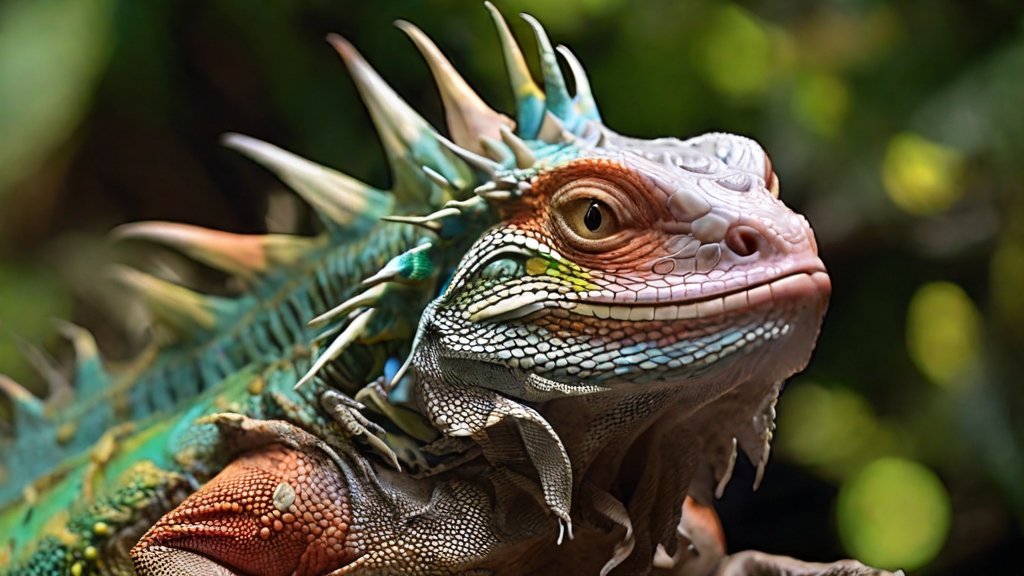If you’ve ever encountered an iguana basking in the sun or gracefully climbing a tree, you might have wondered about their place in the ecosystem. These fascinating creatures are more than just exotic pets or tourist attractions; they play a vital role in their natural habitats. In this article, we’ll explore the intriguing world of iguanas and how they contribute to their ecosystems.
Iguanas, with their prehistoric appearance and colorful skin, are a source of fascination for many. But beyond their striking appearance, these reptiles have an important role to play in their respective ecosystems. Let’s delve deeper into their world and discover how they contribute to the delicate balance of nature.
What Are Iguanas?
Iguanas are a diverse group of lizards belonging to the family Iguanidae. They are primarily found in Central and South America, but some species can also be found in parts of North America, the Caribbean, and the Galapagos Islands. These cold-blooded creatures come in various sizes, with the green iguana being one of the most well-known species.
The Various Species of Iguanas
Iguanas come in different shapes and sizes, and each species has adapted to its specific environment. Some of the notable iguana species include the green iguana, marine iguana, spiny-tailed iguana, and the lesser Antillean iguana. Each of these species has a unique role in its ecosystem.
Iguanas as Herbivores
One of the most significant roles iguanas play is that of herbivores. These lizards have a voracious appetite for vegetation, primarily leaves, fruits, and flowers. Their constant munching on plants helps in controlling the growth of certain plant species, preventing overgrowth in their habitats.
Seed Dispersers Extraordinaire
Iguanas are unwitting gardeners of the forest. As they consume fruits and plants, they inadvertently ingest seeds. These seeds then pass through their digestive system unharmed and are excreted in a new location, often far from where they were originally consumed. This process helps in the dispersal of seeds, contributing to the growth of new plants and maintaining the diversity of the ecosystem.
Keeping Insect Populations in Check
While iguanas primarily feast on plants, they also consume insects. This behavior serves as a natural pest control mechanism, helping to keep insect populations in check. By doing so, they contribute to the overall health of the ecosystem.
Iguanas and Nutrient Cycling
Iguanas play an essential role in nutrient cycling within their ecosystems. Their consumption of plant material and subsequent excretion of waste enriches the soil with essential nutrients. This nutrient cycling aids in the growth of healthier plants and supports a variety of other wildlife that depend on these plants.
Predators and Prey
Iguanas are not at the top of the food chain. They have their own set of predators, including birds of prey, snakes, and large mammals. On the flip side, iguanas also serve as a food source for various species, contributing to the intricate web of predator-prey relationships within their ecosystems.
Ecosystem Balance and Biodiversity
The presence of iguanas in their natural habitats contributes to the overall balance of the ecosystem. They help maintain plant diversity, control insect populations, and provide sustenance for other wildlife. Without iguanas, these delicate ecosystems could become unbalanced, leading to potential disruptions in biodiversity.
Challenges Iguanas Face
Despite their vital roles, iguanas face numerous challenges, primarily due to human activities. Habitat destruction, illegal pet trade, and climate change threaten their populations. Conservation efforts are crucial to ensure the continued survival of these remarkable reptiles.
Conclusion
In conclusion, iguanas are more than just captivating creatures with colorful scales; they are unsung heroes of their ecosystems. Their roles as herbivores, seed dispersers, and pest controllers contribute significantly to maintaining the balance and diversity of their natural habitats. It’s essential that we recognize the importance of these remarkable reptiles and work towards their conservation.
FAQs About Iguanas
What do iguanas eat?
Iguanas are primarily herbivores, feeding on leaves, fruits, and flowers. Some species may also consume insects occasionally.
How do iguanas contribute to their ecosystems?
Iguanas contribute to their ecosystems by dispersing seeds, controlling insect populations, and enriching the soil with nutrients through their waste.
Are iguanas endangered species?
Some species of iguanas are indeed endangered due to habitat destruction and illegal pet trade. Conservation efforts are critical to their survival.
Do iguanas make good pets?
Iguanas can be challenging pets to care for and are not recommended for novice reptile owners. They have specific requirements and can grow quite large.
Are iguanas dangerous to humans?
While iguanas are generally not aggressive, they can become defensive if they feel threatened. Their sharp claws and tails can cause harm if handled improperly, so it’s essential to respect their space in the wild.
In summary, iguanas are not just fascinating reptiles; they are essential components of their ecosystems, playing crucial roles in maintaining the delicate balance of nature. As we admire these creatures, let’s also work towards their conservation to ensure their continued presence in our world.




